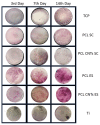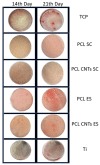The Role of Substrate Topography and Stiffness on MSC Cells Functions: Key Material Properties for Biomimetic Bone Tissue Engineering
- PMID: 35076475
- PMCID: PMC8788532
- DOI: 10.3390/biomimetics7010007
The Role of Substrate Topography and Stiffness on MSC Cells Functions: Key Material Properties for Biomimetic Bone Tissue Engineering
Abstract
The hypothesis of the present research is that by altering the substrate topography and/or stiffness to make it biomimetic, we can modulate cells behavior. Substrates with similar surface chemistry and varying stiffnesses and topographies were prepared. Bulk PCL and CNTs-reinforced PCL composites were manufactured by solvent casting method and electrospinning and further processed to obtain tunable moduli of elasticity in the range of few MPa. To ensure the same chemical profile for the substrates, a protein coating was added. Substrate topography and properties were investigated. Further on, the feedback of Wharton's Jelly Umbilical Cord Mesenchymal Stem Cells to substrates characteristics was investigated. Solvent casting scaffolds displayed superior mechanical properties compared to the corresponding electrospun films. However, the biomimetic fibrous texture of the electrospun substrates induced improved feedback of the cells with respect to their viability and proliferation. Cells' adhesion and differentiation was remarkably pronounced on solvent casting substrates compared to the electrospun substrates. Soft substates improved cells multiplication and migration, while stiff substrates induced differentiation into bone cells. Aspects related to the key factors and the ideal properties of substrates and microenvironments were clarified, aiming towards the deep understanding of the required optimum biomimetic features of biomaterials.
Keywords: biocompatibility; bone tissue regeneration; mesenchymal stem cells; polymeric biomaterials; substrate stiffness.
Conflict of interest statement
The authors declare no conflict of interest.
Figures












Similar articles
-
Cellular activity of Wharton's Jelly-derived mesenchymal stem cells on electrospun fibrous and solvent-cast film scaffolds.J Biomed Mater Res A. 2016 Jan;104(1):218-26. doi: 10.1002/jbm.a.35555. Epub 2015 Sep 18. J Biomed Mater Res A. 2016. PMID: 26265047
-
Harnessing Wharton's jelly stem cell differentiation into bone-like nodule on calcium phosphate substrate without osteoinductive factors.Acta Biomater. 2017 Feb;49:575-589. doi: 10.1016/j.actbio.2016.11.042. Epub 2016 Nov 22. Acta Biomater. 2017. PMID: 27888100
-
Human-derived extracellular matrix from Wharton's jelly: An untapped substrate to build up a standardized and homogeneous coating for vascular engineering.Acta Biomater. 2017 Jan 15;48:227-237. doi: 10.1016/j.actbio.2016.10.018. Epub 2016 Oct 18. Acta Biomater. 2017. PMID: 27769940
-
Cell-matrix mechanical interaction in electrospun polymeric scaffolds for tissue engineering: Implications for scaffold design and performance.Acta Biomater. 2017 Mar 1;50:41-55. doi: 10.1016/j.actbio.2016.12.034. Epub 2016 Dec 21. Acta Biomater. 2017. PMID: 28011142 Review.
-
Development of biomimetic electrospun polymeric biomaterials for bone tissue engineering. A review.J Biomater Sci Polym Ed. 2019 Oct;30(14):1308-1355. doi: 10.1080/09205063.2019.1630699. Epub 2019 Jul 9. J Biomater Sci Polym Ed. 2019. PMID: 31181982 Review.
Cited by
-
Laser-imprinting of micro-3D printed protein hydrogels enables real-time independent modification of substrate topography and elastic modulus.Bioprinting. 2022 Dec;28:e00250. doi: 10.1016/j.bprint.2022.e00250. Epub 2022 Oct 22. Bioprinting. 2022. PMID: 37601117 Free PMC article.
-
Influence of Scaffold Structure and Biomimetic Properties on Adipose Stem Cell Homing in Personalized Reconstructive Medicine.Biomimetics (Basel). 2025 Jul 3;10(7):438. doi: 10.3390/biomimetics10070438. Biomimetics (Basel). 2025. PMID: 40710251 Free PMC article. Review.
-
Nanomechanical Mapping of Three Dimensionally Printed Poly-ε-Caprolactone Single Microfibers at the Cell Scale for Bone Tissue Engineering Applications.Biomimetics (Basel). 2023 Dec 16;8(8):617. doi: 10.3390/biomimetics8080617. Biomimetics (Basel). 2023. PMID: 38132556 Free PMC article.
-
Substrate topographies modulate the secretory activity of human bone marrow mesenchymal stem cells.Stem Cell Res Ther. 2023 Aug 21;14(1):208. doi: 10.1186/s13287-023-03450-0. Stem Cell Res Ther. 2023. PMID: 37605275 Free PMC article.
-
Transit Amplifying Cells (TACs): a still not fully understood cell population.Front Bioeng Biotechnol. 2023 May 9;11:1189225. doi: 10.3389/fbioe.2023.1189225. eCollection 2023. Front Bioeng Biotechnol. 2023. PMID: 37229487 Free PMC article. Review.
References
LinkOut - more resources
Full Text Sources

